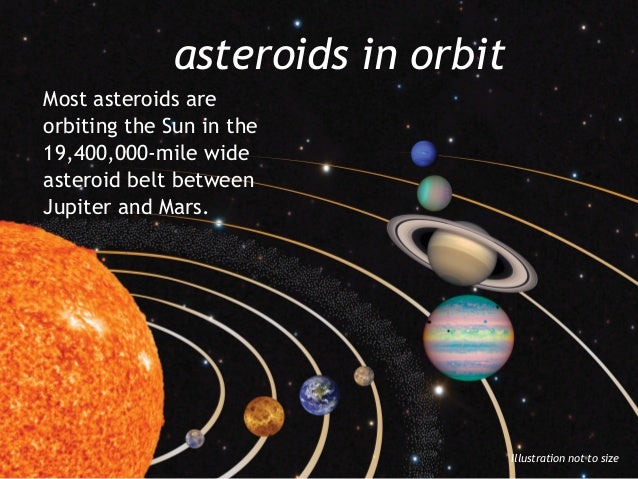Guess what?Asteroids are often referred to as minor planets or planetoids. |
| An asteroid is a rocky body in space which may be only a few hundred feet wide or it may be several hundred miles wide. They are considered to be debrisleft over from the formation of the solar system. Many asteroids orbit the Sun in a region between Mars and Jupiter. This 'belt' of asteroids follows a slightly elliptical path as it orbits the Sun in the same direction as the planets. It takes anywhere from three to six Earth years for a complete revolution around the Sun. An asteroid may be pulled out of its orbit by the gravitational pull of a larger object such as a planet. Once an asteroid is captured by the gravitational pull of a planet, it may become a satellite of that planet. Astronomers theorize that is how the two satellites of Mars, Phobos and Deimos, came to orbit that planet. An asteroid is also capable of colliding with a planet resulting in the formation of an impact crater. Some scientists believe that just such an impact in the area of the Yucatan Peninsula in Mexico started the chain of events which led to the extinction of the dinosaurs here on Earth. Astronomers think that if it were not for the giant planet Jupiter exerting its gravitational force on the asteroids in the belt, the inner planets would be constantly bombarded by large asteroids. The presence of Jupiter actually protects Mercury, Venus, Earth, and Mars from repeated asteroid collisions! |
|
Can Asteroids Orbit The Sun
The Short Answer: Asteroids are small, rocky objects that orbit the Sun. Although asteroids orbit the Sun like planets, they are much smaller than planets. Asteroids are small, rocky objects that orbit the sun. Millions of asteroids exist: many are shattered remnants of planetesimals, bodies within the young Sun's solar nebula that never grew large enough to become planets. The vast majority of known asteroids orbit within the main asteroid belt located between the orbits of Mars and Jupiter, or are co-orbital with Jupiter (the Jupiter trojans). Asteroids orbit our sun, a star, in a region of space between the orbits of Mars and Jupiter known as the Asteroid Belt. One day on asteroid Ida, for example, takes only 4.6 hours (the time it takes for this asteroid to rotate or spin once). Ida makes a complete orbit around the sun (a year in this asteroid's. Most asteroids orbit the sun in a belt between Mars and Jupiter. Scientists think there are probably millions of asteroids, ranging widely in size from hundreds of kilometers across to less than one kilometer (a little more than one-half mile) wide. The Jupiter trojans, commonly called Trojan asteroids or simply Trojans, are a large group of asteroids that share the planet Jupiter 's orbit around the Sun. Relative to Jupiter, each Trojan librates around one of Jupiter's stable Lagrange points: either L4, existing 60° ahead of.
A QuestionWhat prevents the asteroids in the belt from plunging towards the Sun and hitting the inner planets in the process? |
Did you know? | The Answer |
| Show me the Level 1 version of this page. |
The StarChild site is a service of theHigh Energy Astrophysics Science ArchiveResearch Center (HEASARC),Dr. Alan Smale (Director), within theAstrophysics Science Division (ASD) atNASA/GSFC.
StarChild Authors: The StarChild Team
StarChild Graphics & Music: Acknowledgments
StarChild Project Leader: Dr. Laura A.Whitlock
Curator:
Responsible NASA Official:

What is in space? |
How do asteroids orbit?
Almost all of the asteroids in our solar system are orbiting in a broad band 19,400,000 miles wide between Jupiter and Mars. The asteroids are orbiting the Sun, each one traveling around the Sun fast enough for the orbits not to degrade. If something slows an asteroid, it may 'fall' towards the Sun, towards Mars, or towards Jupiter. As both Jupiter and Mars move past the asteroids in their orbits, they may be pulled slightly towards those huge bodies in their orbits. In fact, Phobos and Diemos, the two tiny moons of Mars, may be captured asteroids.
Image from the Solar System Dynamics Group of the Jet Propulsion Laboratory, Solar System Orbits Diagrams and Distribution Graphs Web Page, http://ssd.jpl.nasa.gov/orbit_diagrams.html.
Some scientists believe that the asteroid belt was made when a planet that was there exploded or collided with something else and broke up. Other scientists believe that the material making the asteroids never came together into a planet at all.
The chart below shows how asteroids compare to each other in terms of how far they are from the Sun (semi major axis) and what the shape of their orbit is. Just like many other bodies in the solar system, the orbits made by asteroids are not perfect circles, but ellipses. The axis marked eccentricity is a measure of how far from circular each orbit is. The smaller the eccentricity number is, the more circular the orbit is.

Image from the Solar System Dynamics Group of the Jet Propulsion Laboratory, Solar System Orbits Diagrams and Distribution Graphs Web Page, http://ssd.jpl.nasa.gov/orbit_diagrams.html.
How Fast Do Asteroids Orbit The Sun
What is an asteroid, a planetoid, a meteoroid a micrometeoroid?
What is in space besides planets and stars?
What is an orbit?
What causes an orbit to happen?
What travels in an orbit?
How is an ellipse different from a circle?
What is the orbital plane?
Are there orbits within orbits?
How do we know what's in space?
What are the orbital lengthsand distances of objects in our solar system?
